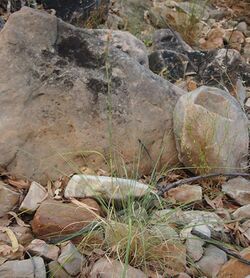Biology:Cymbopogon ambiguus
| Cymbopogon ambiguus | |
|---|---|

| |
| Scientific classification | |
| Kingdom: | Plantae |
| Clade: | Tracheophytes |
| Clade: | Angiosperms |
| Clade: | Monocots |
| Clade: | Commelinids |
| Order: | Poales |
| Family: | Poaceae |
| Subfamily: | Panicoideae |
| Genus: | Cymbopogon |
| Species: | C. ambiguus
|
| Binomial name | |
| Cymbopogon ambiguus A.Camus
| |
Cymbopogon ambiguus, or Australian lemon-scented grass, is a plant species in the family Poaceae.[1] It has fragrant, bluish-green grey leaves and fluffy seed heads. It is self-fertile.
Cultivation
Cymbopogon ambiguus needs a sunny position. It can tolerate extreme dryness once established.[citation needed] Propagation is by division of clumps or from seed. Lemongrass can be grown in any soil and needs very little water. It grows to a height of 1.8 m (5 ft 11 in).[citation needed]
Uses
Infusions and concoctions of Cymbopogon ambiguus have been used in traditional Aboriginal Australian medicine to treat headaches, chest infections, and muscle cramps.[1] It has also been proposed as a candidate for rhizoremediation of hydrocarbon-contaminated soils.[2]
Read also
References
- ↑ 1.0 1.1 Grice, I. Darren; Rogers, Kelly L.; Griffiths, Lyn R. (2011). "Isolation of Bioactive Compounds That Relate to the Anti-Platelet Activity of Cymbopogon ambiguus" (in en). Evidence-Based Complementary and Alternative Medicine 2011: 1–8. doi:10.1093/ecam/nep213. PMID 20047890.
- ↑ Gaskin, Sharyn E.; Bentham, Richard H. (2010-08-01). "Rhizoremediation of hydrocarbon contaminated soil using Australian native grasses" (in en). Science of the Total Environment 408 (17): 3683–3688. doi:10.1016/j.scitotenv.2010.05.004. ISSN 0048-9697. PMID 20569970. Bibcode: 2010ScTEn.408.3683G. https://www.sciencedirect.com/science/article/pii/S0048969710004602.
Wikidata ☰ Q568756 entry
 |

